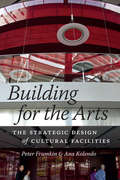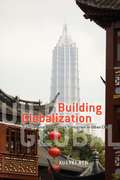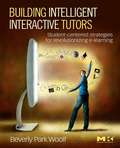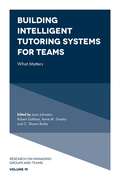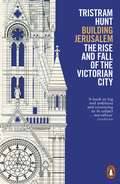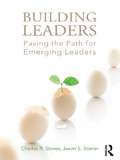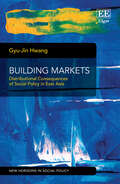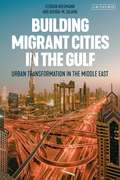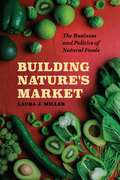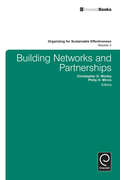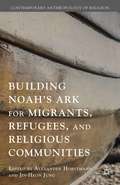- Table View
- List View
Building for the Arts: The Strategic Design of Cultural Facilities
by Peter Frumkin Ana KolendoOver the past two decades, the arts in America have experienced an unprecedented building boom, with more than sixteen billion dollars directed to the building, expansion, and renovation of museums, theaters, symphony halls, opera houses, and centers for the visual and performing arts. Among the projects that emerged from the boom were many brilliant successes. Others, like the striking addition of the Quadracci Pavilion to the Milwaukee Art Museum, brought international renown but also tens of millions of dollars of off-budget debt while offering scarce additional benefit to the arts and embodying the cultural sector’s worst fears that the arts themselves were being displaced by the big, status-driven architecture projects built to contain them. With Building for the Arts, Peter Frumkin and Ana Kolendo explore how artistic vision, funding partnerships, and institutional culture work together—or fail to—throughout the process of major cultural construction projects. Drawing on detailed case studies and in-depth interviews at museums and other cultural institutions varying in size and funding arrangements, including the Art Institute of Chicago, Atlanta Opera, and AT&T Performing Arts Center in Dallas, Frumkin and Kolendo analyze the decision-making considerations and challenges and identify four factors whose alignment characterizes the most successful and sustainable of the projects discussed: institutional requirements, capacity of the institution to manage the project while maintaining ongoing operations, community interest and support, and sufficient sources of funding. How and whether these factors are strategically aligned in the design and execution of a building initiative, the authors argue, can lead an organization to either thrive or fail. The book closes with an analysis of specific tactics that can enhance the chances of a project’s success. A practical guide grounded in the latest scholarship on nonprofit strategy and governance, Building for the Arts will be an invaluable resource for professional arts staff and management, trustees of arts organizations, development professionals, and donors, as well as those who study and seek to understand them.
Building for the Arts: The Strategic Design of Cultural Facilities
by Peter Frumkin Ana KolendoOver the past two decades, the arts in America have experienced an unprecedented building boom, with more than sixteen billion dollars directed to the building, expansion, and renovation of museums, theaters, symphony halls, opera houses, and centers for the visual and performing arts. Among the projects that emerged from the boom were many brilliant successes. Others, like the striking addition of the Quadracci Pavilion to the Milwaukee Art Museum, brought international renown but also tens of millions of dollars of off-budget debt while offering scarce additional benefit to the arts and embodying the cultural sector’s worst fears that the arts themselves were being displaced by the big, status-driven architecture projects built to contain them. With Building for the Arts, Peter Frumkin and Ana Kolendo explore how artistic vision, funding partnerships, and institutional culture work together—or fail to—throughout the process of major cultural construction projects. Drawing on detailed case studies and in-depth interviews at museums and other cultural institutions varying in size and funding arrangements, including the Art Institute of Chicago, Atlanta Opera, and AT&T Performing Arts Center in Dallas, Frumkin and Kolendo analyze the decision-making considerations and challenges and identify four factors whose alignment characterizes the most successful and sustainable of the projects discussed: institutional requirements, capacity of the institution to manage the project while maintaining ongoing operations, community interest and support, and sufficient sources of funding. How and whether these factors are strategically aligned in the design and execution of a building initiative, the authors argue, can lead an organization to either thrive or fail. The book closes with an analysis of specific tactics that can enhance the chances of a project’s success. A practical guide grounded in the latest scholarship on nonprofit strategy and governance, Building for the Arts will be an invaluable resource for professional arts staff and management, trustees of arts organizations, development professionals, and donors, as well as those who study and seek to understand them.
Building Globalization: Transnational Architecture Production in Urban China
by Xuefei RenFrom the years 2004 to 2008, Beijing and Shanghai witnessed the construction of an extraordinary number of new buildings, many of which were designed by architectural firms overseas. Combining ethnographic fieldwork, historical research, and network analysis, Building Globalization closely scrutinizes the growing phenomenon of transnational architecture and its profound effect on the development of urban space. Roaming from construction sites in Shanghai to architects’ offices in Paris, Xuefei Ren interviews hundreds of architects, developers, politicians, residents, and activists to explore this issue. She finds that in the rapidly transforming cities of modern China, iconic designs from prestigious international architects help private developers to distinguish their projects, government officials to advance their careers, and the Chinese state to announce the arrival of modern China on the world stage. China leads the way in the globalization of architecture, a process whose ramifications can be felt from Beijing to Dubai to Basel. Connecting the dots between real estate speculation, megaproject construction, residential displacement, historical preservation, housing rights, and urban activism, Building Globalization reveals the contradictions and consequences of this new, global urban frontier.
Building Globalization: Transnational Architecture Production in Urban China
by Xuefei RenFrom the years 2004 to 2008, Beijing and Shanghai witnessed the construction of an extraordinary number of new buildings, many of which were designed by architectural firms overseas. Combining ethnographic fieldwork, historical research, and network analysis, Building Globalization closely scrutinizes the growing phenomenon of transnational architecture and its profound effect on the development of urban space. Roaming from construction sites in Shanghai to architects’ offices in Paris, Xuefei Ren interviews hundreds of architects, developers, politicians, residents, and activists to explore this issue. She finds that in the rapidly transforming cities of modern China, iconic designs from prestigious international architects help private developers to distinguish their projects, government officials to advance their careers, and the Chinese state to announce the arrival of modern China on the world stage. China leads the way in the globalization of architecture, a process whose ramifications can be felt from Beijing to Dubai to Basel. Connecting the dots between real estate speculation, megaproject construction, residential displacement, historical preservation, housing rights, and urban activism, Building Globalization reveals the contradictions and consequences of this new, global urban frontier.
Building Globalization: Transnational Architecture Production in Urban China
by Xuefei RenFrom the years 2004 to 2008, Beijing and Shanghai witnessed the construction of an extraordinary number of new buildings, many of which were designed by architectural firms overseas. Combining ethnographic fieldwork, historical research, and network analysis, Building Globalization closely scrutinizes the growing phenomenon of transnational architecture and its profound effect on the development of urban space. Roaming from construction sites in Shanghai to architects’ offices in Paris, Xuefei Ren interviews hundreds of architects, developers, politicians, residents, and activists to explore this issue. She finds that in the rapidly transforming cities of modern China, iconic designs from prestigious international architects help private developers to distinguish their projects, government officials to advance their careers, and the Chinese state to announce the arrival of modern China on the world stage. China leads the way in the globalization of architecture, a process whose ramifications can be felt from Beijing to Dubai to Basel. Connecting the dots between real estate speculation, megaproject construction, residential displacement, historical preservation, housing rights, and urban activism, Building Globalization reveals the contradictions and consequences of this new, global urban frontier.
Building Globalization: Transnational Architecture Production in Urban China
by Xuefei RenFrom the years 2004 to 2008, Beijing and Shanghai witnessed the construction of an extraordinary number of new buildings, many of which were designed by architectural firms overseas. Combining ethnographic fieldwork, historical research, and network analysis, Building Globalization closely scrutinizes the growing phenomenon of transnational architecture and its profound effect on the development of urban space. Roaming from construction sites in Shanghai to architects’ offices in Paris, Xuefei Ren interviews hundreds of architects, developers, politicians, residents, and activists to explore this issue. She finds that in the rapidly transforming cities of modern China, iconic designs from prestigious international architects help private developers to distinguish their projects, government officials to advance their careers, and the Chinese state to announce the arrival of modern China on the world stage. China leads the way in the globalization of architecture, a process whose ramifications can be felt from Beijing to Dubai to Basel. Connecting the dots between real estate speculation, megaproject construction, residential displacement, historical preservation, housing rights, and urban activism, Building Globalization reveals the contradictions and consequences of this new, global urban frontier.
Building Globalization: Transnational Architecture Production in Urban China
by Xuefei RenFrom the years 2004 to 2008, Beijing and Shanghai witnessed the construction of an extraordinary number of new buildings, many of which were designed by architectural firms overseas. Combining ethnographic fieldwork, historical research, and network analysis, Building Globalization closely scrutinizes the growing phenomenon of transnational architecture and its profound effect on the development of urban space. Roaming from construction sites in Shanghai to architects’ offices in Paris, Xuefei Ren interviews hundreds of architects, developers, politicians, residents, and activists to explore this issue. She finds that in the rapidly transforming cities of modern China, iconic designs from prestigious international architects help private developers to distinguish their projects, government officials to advance their careers, and the Chinese state to announce the arrival of modern China on the world stage. China leads the way in the globalization of architecture, a process whose ramifications can be felt from Beijing to Dubai to Basel. Connecting the dots between real estate speculation, megaproject construction, residential displacement, historical preservation, housing rights, and urban activism, Building Globalization reveals the contradictions and consequences of this new, global urban frontier.
Building Globalization: Transnational Architecture Production in Urban China
by Xuefei RenFrom the years 2004 to 2008, Beijing and Shanghai witnessed the construction of an extraordinary number of new buildings, many of which were designed by architectural firms overseas. Combining ethnographic fieldwork, historical research, and network analysis, Building Globalization closely scrutinizes the growing phenomenon of transnational architecture and its profound effect on the development of urban space. Roaming from construction sites in Shanghai to architects’ offices in Paris, Xuefei Ren interviews hundreds of architects, developers, politicians, residents, and activists to explore this issue. She finds that in the rapidly transforming cities of modern China, iconic designs from prestigious international architects help private developers to distinguish their projects, government officials to advance their careers, and the Chinese state to announce the arrival of modern China on the world stage. China leads the way in the globalization of architecture, a process whose ramifications can be felt from Beijing to Dubai to Basel. Connecting the dots between real estate speculation, megaproject construction, residential displacement, historical preservation, housing rights, and urban activism, Building Globalization reveals the contradictions and consequences of this new, global urban frontier.
Building Intelligent Interactive Tutors: Student-centered Strategies for Revolutionizing E-learning
by Beverly Park WoolfBuilding Intelligent Interactive Tutors discusses educational systems that assess a student's knowledge and are adaptive to a student's learning needs. The impact of computers has not been generally felt in education due to lack of hardware, teacher training, and sophisticated software. and because current instructional software is neither truly responsive to student needs nor flexible enough to emulate teaching. Dr. Woolf taps into 20 years of research on intelligent tutors to bring designers and developers a broad range of issues and methods that produce the best intelligent learning environments possible, whether for classroom or life-long learning. The book describes multidisciplinary approaches to using computers for teaching, reports on research, development, and real-world experiences, and discusses intelligent tutors, web-based learning systems, adaptive learning systems, intelligent agents and intelligent multimedia. It is recommended for professionals, graduate students, and others in computer science and educational technology who are developing online tutoring systems to support e-learning, and who want to build intelligence into the system.Combines both theory and practice to offer most in-depth and up-to-date treatment of intelligent tutoring systems availablePresents powerful drivers of virtual teaching systems, including cognitive science, artificial intelligence, and the InternetFeatures algorithmic material that enables programmers and researchers to design building components and intelligent systems
Building Intelligent Tutoring Systems for Teams: What Matters (Research on Managing Groups and Teams #19)
by Joan Johnston Robert Sottilare Anne M. Sinatra C. Shawn BurkeThis volume presents multidisciplinary perspectives from leading scholars in the science of teams and intelligent tutoring systems (ITSs) on research needed to advance the state of the art of team ITSs. Our esteemed authors provide lessons learned to guide future research that will produce the technical capabilities needed to support team skills development. The introduction by Drs. Robert Sottilare and Eduardo Salas, who are leaders in the field of ITSs and team science, discusses the challenges and approaches to building ITSs for teams. The volume’s first section introduces concepts for understanding team training such as team task analysis, team macrocognition, measurement strategies for dynamic processes, and effective team training methods to provide insights into ITS design. Section two presents recent advances in team assessment and feedback through unobtrusive assessments, modeling dynamic team interactions, neurodynamic scaffolding, and collaborative tutoring strategies. In the Volume’s third section authors discuss lessons learned from past research, provide a discourse on the five disciplinary perspectives of engineering, learning sciences, team research, data analysis, and human computer interaction to create a framework for guiding team ITS developers, and examine the team ITS requirements for long term space travel. The final chapter summarizes and integrates lessons learned and provides recommendations for future research and development.
Building Intelligent Tutoring Systems for Teams: What Matters (Research on Managing Groups and Teams #19)
by Joan Johnston Robert Sottilare Anne M. Sinatra C. Shawn BurkeThis volume presents multidisciplinary perspectives from leading scholars in the science of teams and intelligent tutoring systems (ITSs) on research needed to advance the state of the art of team ITSs. Our esteemed authors provide lessons learned to guide future research that will produce the technical capabilities needed to support team skills development. The introduction by Drs. Robert Sottilare and Eduardo Salas, who are leaders in the field of ITSs and team science, discusses the challenges and approaches to building ITSs for teams. The volume’s first section introduces concepts for understanding team training such as team task analysis, team macrocognition, measurement strategies for dynamic processes, and effective team training methods to provide insights into ITS design. Section two presents recent advances in team assessment and feedback through unobtrusive assessments, modeling dynamic team interactions, neurodynamic scaffolding, and collaborative tutoring strategies. In the Volume’s third section authors discuss lessons learned from past research, provide a discourse on the five disciplinary perspectives of engineering, learning sciences, team research, data analysis, and human computer interaction to create a framework for guiding team ITS developers, and examine the team ITS requirements for long term space travel. The final chapter summarizes and integrates lessons learned and provides recommendations for future research and development.
Building Jerusalem: The Rise and Fall of the Victorian City
by Tristram Hunt'History writing at its compulsive best' A. N. WilsonThis is a history of the ideas that shaped not only London, but Manchester, Glasgow, Liverpool, Leeds, Birmingham, Sheffield and other power-houses of 19th-century Britain. It charts the controversies and visions that fostered Britain's greatest civic renaissance.Tristram Hunt explores the horrors of the Victorian city, as seen by Dickens, Engels and Carlyle; the influence of the medieval Gothic ideal of faith, community and order espoused by Pugin and Ruskin; the pride in self-government, identified with the Saxons as opposed to the Normans; the identification with the city republics of the Italian renaissance - commerce, trade and patronage; the change from the civic to the municipal, and greater powers over health, education and housing; and finally at the end of the century, the retreat from the urban to the rural ideal, led by William Morris and the garden-city movement of Ebenezer Howard.
Building Leaders: Paving the Path for Emerging Leaders
by Charles R. Stoner Jason S. StonerThis book is written for emerging leaders. It is designed to help these leaders bridge the gap from stepping into a position of leadership and emerging as a confident and respected difference-maker. Within this text, award-winning scholar and leader-coach Charles Stoner meets emerging leaders where they are and focus on the issues that are most problematic for them. From the development of leadership skills to the practice and application of successful strategies, Stoner offers tools, ideas, and evidence-based advice to these up-and-coming leaders in an indispensable text that is direct, pragmatic, and action-oriented. Major topics include: Recognition, development, and practice of organizational leadership skills. Enhancing interpersonal dynamics and relationships. Organizational politics and interpersonal influence, creativity and innovation, negotiation and conflict resolution. Handling problem situations; effectively utilizing diverse talents and personalities. Introduction to major leadership and interpersonal development techniques. Case studies.
Building Leaders: Paving the Path for Emerging Leaders
by Charles R. Stoner Jason S. StonerThis book is written for emerging leaders. It is designed to help these leaders bridge the gap from stepping into a position of leadership and emerging as a confident and respected difference-maker. Within this text, award-winning scholar and leader-coach Charles Stoner meets emerging leaders where they are and focus on the issues that are most problematic for them. From the development of leadership skills to the practice and application of successful strategies, Stoner offers tools, ideas, and evidence-based advice to these up-and-coming leaders in an indispensable text that is direct, pragmatic, and action-oriented. Major topics include: Recognition, development, and practice of organizational leadership skills. Enhancing interpersonal dynamics and relationships. Organizational politics and interpersonal influence, creativity and innovation, negotiation and conflict resolution. Handling problem situations; effectively utilizing diverse talents and personalities. Introduction to major leadership and interpersonal development techniques. Case studies.
Building Markets: Distributional Consequences of Social Policy in East Asia (New Horizons in Social Policy series)
by Gyu-Jin HwangNowhere in the world presents a more dramatic case of wealth creation than East Asia. Contrary to the common belief that social policy in the economic powerhouses of the region is secondary to their pursuit of economic growth, Gyu-Jin Hwang argues that it has in fact played an integral part in building strong states and competitive market economies. Building Markets examines the original four Newly Industrialised Economies (NIEs) of East Asia: Hong Kong, Korea, Singapore, and Taiwan, as well as Japan, the regional forerunner in both economic and social terms. Chapters undertake a comparative analysis of the various social policy measures and redistributive efforts taken across a diverse range of social policy sectors in the region, covering cash transfers, healthcare, education, housing, and family policy. Addressing the mounting pressure on East Asian economies to rethink their growth strategies, Hwang concludes with a call for social means to be diverted, adapted, and converted to serve new social ends. Integrating cutting-edge theoretical insights with detailed policy analysis, Building Markets will be an invaluable tool for academics and postgraduate students interested in social policy, economics, and development in East Asia.
Building Migrant Cities in the Gulf: Urban Transformation in the Middle East
by Florian Wiedmann Ashraf M. SalamaHuman history has seen many settlements transformed or built entirely by expatriate work forces and foreigners arriving from various places. Recent migration patterns in the Gulf have led to emerging 'airport societies' on unprecedented scales. Most guest workers, both labourers and mid to high-income groups, perceive their stay as a temporary opportunity to earn suitable income or gain experience. This timely book analyses the essential characteristics of this unique urban phenomenon substantiated by concrete examples and empirical research. Both authors have lived and worked in the Gulf including Qatar, Bahrain and the United Arab Emirates during various periods between 2006 and 2014. They explore Gulf cities from macro and interconnected perspectives rather than focusing solely on singular aspects within the built environment. As academic architects specialised in urbanism and the complex dynamics between people and places the authors build new bridges for understanding demographic and social changes impacting urban transformations in the Gulf.
Building Migrant Cities in the Gulf: Urban Transformation in the Middle East
by Florian Wiedmann Ashraf M. SalamaHuman history has seen many settlements transformed or built entirely by expatriate work forces and foreigners arriving from various places. Recent migration patterns in the Gulf have led to emerging 'airport societies' on unprecedented scales. Most guest workers, both labourers and mid to high-income groups, perceive their stay as a temporary opportunity to earn suitable income or gain experience. This timely book analyses the essential characteristics of this unique urban phenomenon substantiated by concrete examples and empirical research. Both authors have lived and worked in the Gulf including Qatar, Bahrain and the United Arab Emirates during various periods between 2006 and 2014. They explore Gulf cities from macro and interconnected perspectives rather than focusing solely on singular aspects within the built environment. As academic architects specialised in urbanism and the complex dynamics between people and places the authors build new bridges for understanding demographic and social changes impacting urban transformations in the Gulf.
Building Nature's Market: The Business and Politics of Natural Foods
by Laura J. MillerFor the first 150 years of their existence, “natural foods” were consumed primarily by body builders, hippies, religious sects, and believers in nature cure. And those consumers were dismissed by the medical establishment and food producers as kooks, faddists, and dangerous quacks. In the 1980s, broader support for natural foods took hold and the past fifteen years have seen an explosion—everything from healthy-eating superstores to mainstream institutions like hospitals, schools, and workplace cafeterias advertising their fresh-from-the-garden ingredients. Building Nature’s Market shows how the meaning of natural foods was transformed as they changed from a culturally marginal, religiously inspired set of ideas and practices valorizing asceticism to a bohemian lifestyle to a mainstream consumer choice. Laura J. Miller argues that the key to understanding this transformation is to recognize the leadership of the natural foods industry. Rather than a simple tale of cooptation by market forces, Miller contends the participation of business interests encouraged the natural foods movement to be guided by a radical skepticism of established cultural authority. She challenges assumptions that private enterprise is always aligned with social elites, instead arguing that profit-minded entities can make common cause with and even lead citizens in advocating for broad-based social and cultural change.
Building Nature's Market: The Business and Politics of Natural Foods
by Laura J. MillerFor the first 150 years of their existence, “natural foods” were consumed primarily by body builders, hippies, religious sects, and believers in nature cure. And those consumers were dismissed by the medical establishment and food producers as kooks, faddists, and dangerous quacks. In the 1980s, broader support for natural foods took hold and the past fifteen years have seen an explosion—everything from healthy-eating superstores to mainstream institutions like hospitals, schools, and workplace cafeterias advertising their fresh-from-the-garden ingredients. Building Nature’s Market shows how the meaning of natural foods was transformed as they changed from a culturally marginal, religiously inspired set of ideas and practices valorizing asceticism to a bohemian lifestyle to a mainstream consumer choice. Laura J. Miller argues that the key to understanding this transformation is to recognize the leadership of the natural foods industry. Rather than a simple tale of cooptation by market forces, Miller contends the participation of business interests encouraged the natural foods movement to be guided by a radical skepticism of established cultural authority. She challenges assumptions that private enterprise is always aligned with social elites, instead arguing that profit-minded entities can make common cause with and even lead citizens in advocating for broad-based social and cultural change.
Building Nature's Market: The Business and Politics of Natural Foods
by Laura J. MillerFor the first 150 years of their existence, “natural foods” were consumed primarily by body builders, hippies, religious sects, and believers in nature cure. And those consumers were dismissed by the medical establishment and food producers as kooks, faddists, and dangerous quacks. In the 1980s, broader support for natural foods took hold and the past fifteen years have seen an explosion—everything from healthy-eating superstores to mainstream institutions like hospitals, schools, and workplace cafeterias advertising their fresh-from-the-garden ingredients. Building Nature’s Market shows how the meaning of natural foods was transformed as they changed from a culturally marginal, religiously inspired set of ideas and practices valorizing asceticism to a bohemian lifestyle to a mainstream consumer choice. Laura J. Miller argues that the key to understanding this transformation is to recognize the leadership of the natural foods industry. Rather than a simple tale of cooptation by market forces, Miller contends the participation of business interests encouraged the natural foods movement to be guided by a radical skepticism of established cultural authority. She challenges assumptions that private enterprise is always aligned with social elites, instead arguing that profit-minded entities can make common cause with and even lead citizens in advocating for broad-based social and cultural change.
Building Nature's Market: The Business and Politics of Natural Foods
by Laura J. MillerFor the first 150 years of their existence, “natural foods” were consumed primarily by body builders, hippies, religious sects, and believers in nature cure. And those consumers were dismissed by the medical establishment and food producers as kooks, faddists, and dangerous quacks. In the 1980s, broader support for natural foods took hold and the past fifteen years have seen an explosion—everything from healthy-eating superstores to mainstream institutions like hospitals, schools, and workplace cafeterias advertising their fresh-from-the-garden ingredients. Building Nature’s Market shows how the meaning of natural foods was transformed as they changed from a culturally marginal, religiously inspired set of ideas and practices valorizing asceticism to a bohemian lifestyle to a mainstream consumer choice. Laura J. Miller argues that the key to understanding this transformation is to recognize the leadership of the natural foods industry. Rather than a simple tale of cooptation by market forces, Miller contends the participation of business interests encouraged the natural foods movement to be guided by a radical skepticism of established cultural authority. She challenges assumptions that private enterprise is always aligned with social elites, instead arguing that profit-minded entities can make common cause with and even lead citizens in advocating for broad-based social and cultural change.
Building Nature's Market: The Business and Politics of Natural Foods
by Laura J. MillerFor the first 150 years of their existence, “natural foods” were consumed primarily by body builders, hippies, religious sects, and believers in nature cure. And those consumers were dismissed by the medical establishment and food producers as kooks, faddists, and dangerous quacks. In the 1980s, broader support for natural foods took hold and the past fifteen years have seen an explosion—everything from healthy-eating superstores to mainstream institutions like hospitals, schools, and workplace cafeterias advertising their fresh-from-the-garden ingredients. Building Nature’s Market shows how the meaning of natural foods was transformed as they changed from a culturally marginal, religiously inspired set of ideas and practices valorizing asceticism to a bohemian lifestyle to a mainstream consumer choice. Laura J. Miller argues that the key to understanding this transformation is to recognize the leadership of the natural foods industry. Rather than a simple tale of cooptation by market forces, Miller contends the participation of business interests encouraged the natural foods movement to be guided by a radical skepticism of established cultural authority. She challenges assumptions that private enterprise is always aligned with social elites, instead arguing that profit-minded entities can make common cause with and even lead citizens in advocating for broad-based social and cultural change.
Building Nature's Market: The Business and Politics of Natural Foods
by Laura J. MillerFor the first 150 years of their existence, “natural foods” were consumed primarily by body builders, hippies, religious sects, and believers in nature cure. And those consumers were dismissed by the medical establishment and food producers as kooks, faddists, and dangerous quacks. In the 1980s, broader support for natural foods took hold and the past fifteen years have seen an explosion—everything from healthy-eating superstores to mainstream institutions like hospitals, schools, and workplace cafeterias advertising their fresh-from-the-garden ingredients. Building Nature’s Market shows how the meaning of natural foods was transformed as they changed from a culturally marginal, religiously inspired set of ideas and practices valorizing asceticism to a bohemian lifestyle to a mainstream consumer choice. Laura J. Miller argues that the key to understanding this transformation is to recognize the leadership of the natural foods industry. Rather than a simple tale of cooptation by market forces, Miller contends the participation of business interests encouraged the natural foods movement to be guided by a radical skepticism of established cultural authority. She challenges assumptions that private enterprise is always aligned with social elites, instead arguing that profit-minded entities can make common cause with and even lead citizens in advocating for broad-based social and cultural change.
Building Networks and Partnerships (Organizing for Sustainable Effectiveness #3)
by Philip H. Mirvis Abraham B. ShaniOrganizing for Sustainable Effectiveness highlights research and practice aimed at understanding how organizations and more inclusive systems of actors develop a continuous, unfaltering focus on sustainability. It will examine how they organize to achieve expanded purposes, the associated changes in purpose and governance, relationships among various stakeholders, boundaries between organizations and other elements of the environment in which they operate, organizational systems and processes, leadership, competencies and capabilities. Thus 'sustainability' is seen as entailing a continuous dynamic adaptive process in people, organizations and systems, striving to be as proactive as possible, moving 'upstream' in improving and developing organizational processes and issues.
Building Noah’s Ark for Migrants, Refugees, and Religious Communities (Contemporary Anthropology of Religion)
by Jin-Heon JungBuilding Noah's Ark for Migrants, Refugees, and Religious Communities examines religion within the framework of refugee studies as a public good, with the spiritual and material use of religion shedding new light on the agency of refugees in reconstructing their lives and positioning themselves in hostile environments.
